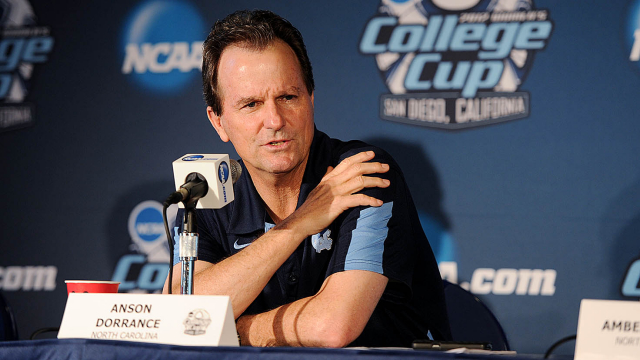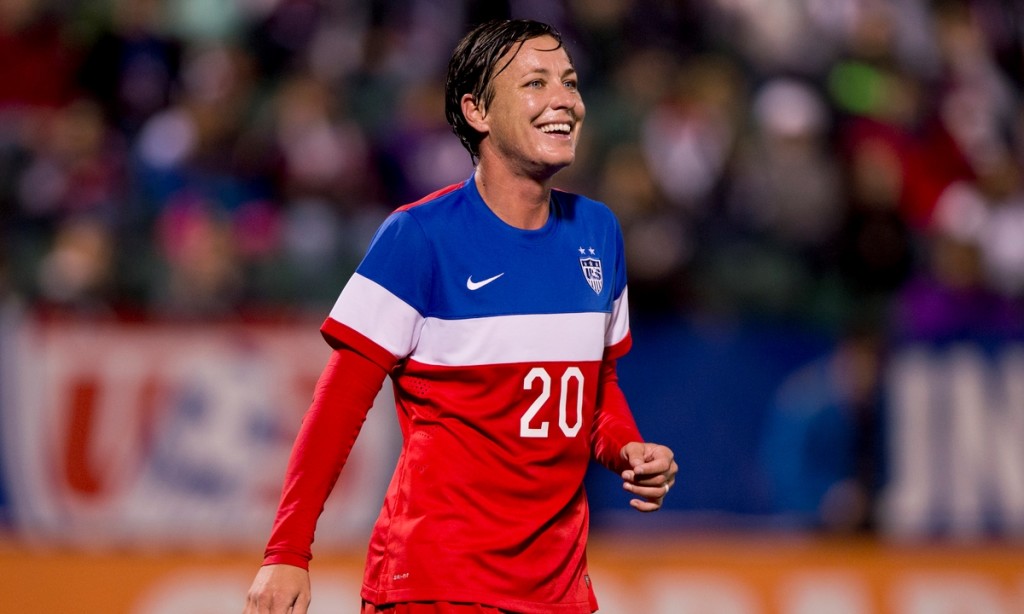Former UNC Captain Pam Kalinoski on the Importance of Female Coaches
This article was published when Kalinoski coached at Carlsbad United, a youth soccer club that had a strong history of supporting female coaches.
When Pamela Kalinoski stepped on the pitch at the University of North Carolina Chapel Hill (UNC) as a walk-on in 1987, she brought with her a solid resume at the high school level and a determination to succeed.
Four years later she closed out her career as a four-year letter winner and team captain of a squad that included future U.S. Women’s National Team members Mia Hamm, Kristine Lilly, Carla Overbeck and Tisha Venturini. Today Kalinoski brings her years of experience to the role of GU15 Premier II and GU16 Premier head coach at Carlsbad United F.C.

A two-year Northeast Player of the Year at North Olmstead High School in Ohio, Kalinoski kicked off her UNC career as a member of the Soccer America All-Freshman Team.
In 1988, she was named to the NCAA Final Four All-Tournament Team and played on NCAA Division I Champion squads all four years. Her best year was 1991 when, with Hamm, Lilly, Overbeck and Venturini, she made up one of the most dangerous women’s attacks in college soccer.
That year she was again named to the NCAA Final Four All-Tournament Team and was the NCAA All-Tournament Offensive Most Valuable Player.
Kalinoski ended her college soccer career as the then-No. 1 player in Single Season Assists at UNC with 28 in 1991, a record only beaten by Hamm with 33 in 1992. That number also puts her in the Top-10 in NCAA Women’s Soccer, and her 51 career assists rank her as UNC Top 10 and NCAA Top 25. Kalinoski also ranks Top 10 in NCAA Division I for Assists per Game in a Season.
After college Kalinoski continued to compete at the semi-pro level for the Women’s Premier Soccer League (WPSL) California Storm until an ACL tear ended her playing career. She then moved on to coaching, where she has been both an assistant and head coach at the college level. Kalinoski spent four season as assistant coach at the University of Memphis before moving on to take the same role at the University of San Francisco in 1999. Two years later she was named the team’s head coach and led the Lady Dons to a 42-68-9 record over six seasons.
Her passion for soccer is well known and has been recognized by former teammates and coaches alike.
“Her passion for the game is tremendous and she will enforce that with the team,” says former teammate Overbeck. “Her kids will benefit from her experience as a highly competitive player and will go away with not only improved soccer skills, but important life lessons as well.”
“Teams play with the personality of their coach,” says legendary UNC head coach Anson Dorrance. “The more these kids are around Pamela the more they are going to reflect her competitive attitude. They’re going to have great balance at and they’re going to love the atmosphere Pamela creates.”

Recently Kalinoski shared her thoughts about her careers as a player and a coach and the importance of female coaches with SoccerToday editor Diane Scavuzzo.
Diane Scavuzzo: When did you first begin playing soccer?
Pam Kalinoski: I started at age four when I lived in Cleveland, Ohio.
Diane Scavuzzo: Can you tell us a little about your playing career? For instance, did you ever play professionally?
Pam Kalinoski: I did not play pro, but we did win the NCAA championship all my years at UNC. I played semi-pro for the California Storm after college, but stopped playing after my second ACL tear.
Diane Scavuzzo: Did you have any female coaches when you were a youth or college player?
Pam Kalinoski: I did have a female coach as a youth player and she was great, but she was also one of my teammates’ mothers and the team was initially coached by her husband. I think the fact she was so much older and was a mother to one of the other players on my team allowed her to take on that motherly role for me.
Diane Scavuzzo: Why do you think there are so few women coaches in soccer?
Pam Kalinoski: I think the reason why there are a limited number of female coaches is that they are less interested in making it a lifestyle, per se’. Coaching can be incredibly time consuming at all ages, and so adding family obligations could be another reason.
I also think being a male dominated profession at all levels, there have been few true successful women coaching stories, or at least they have not been promoted as those of male coaches are.
Diane Scavuzzo: Why have female coaches not been more popular, welcomed in youth soccer or professional soccer?
Pam Kalinoski: I think it comes down to a lack of universal respect for their ability, or the few female coaches that are actually devoting the time to coaching. There should be more promotion of the fact this past year in both Division I college and in the women’s professional league, the winning teams in both were coached by females.
Diane Scavuzzo: Do female coaches face any special challenges?
Pam Kalinoski: The biggest challenges I would foresee are simply being fully respected for their ability to coach and not having the fact they are female dictate how they are treated in the coach/player relationship. I think it can be a positive, but it can also be a negative at times when the dynamic becomes too emotional and interferes with the coaching.
Diane Scavuzzo: What do you see as some of the differences between women and male coaches?
Pam Kalinoski: The greatest difference I have experienced comes from the personalities and the relationships that are formed with a female coach. There is a greater value placed on the relationship with women, whether they are coaching girls or boys.
Diane Scavuzzo: What traits does a female coach need to survive and thrive?
Pam Kalinoski: A good female coach needs many of the same traits a male coach needs to survive and thrive. She must be confident in her ability, both in knowing the game and knowing her players and what her players need. She needs to be able to find a balance of being demanding and praising while developing respect from her team. She must be organized and flexible. She must be open.
Diane Scavuzzo: What needs to change so that more female coaches can make it?
Pam Kalinoski: Anson used to have a statement during pre game in the locker room, which was once referred to as the hut back in the day, and that is, ‘All you future coaches of America.’ When I graduated from college I had no desire to coach soccer, but that changed. I have coached both Division I and club and still remain connected to the game 20 years later. There should be incentive for female coaches in a club.
Diane Scavuzzo: How important do you think it is to have the same gender coach if you are a girl or boy? How do girls’ teams benefit from having a female coach?
Pam Kalinoski: In regards to the same gender coach, as we know having a male coach girls is much more common than a female coaching boys. But I do think girls place a greater value on the relationship with the individual coaching them, so being female seems to allow for that relationship to be developed quicker and stronger.
There also is the relatability factor that is contained in having the same gender coach and player, especially in females. I think the role model can be created with both male and female coaches, but I think it is important for girls to experience a female coach.
Diane Scavuzzo: What is the difference between coaching girls and boys?
Pam Kalinoski: I think a lot of the difference stems from the delivery of information and the way you coach them. Often girls need to be raised up or built up, where boys with their ego need to be brought down a little.
Diane Scavuzzo: What do you think about the state of women’s soccer in the USA?
Pam Kalinoski: I think they are managing the women’s professional league better, where it will hopefully be able to sustain itself. But the unfortunate part is, I think this generation of players is delivering a different message to the girls. I think there needs to be SO much more invested in the overall promotion of the female soccer players as a whole.
They need to be on TV and paid better salaries to allow them to make this profession be full time. They should be doing more human interest stories on female soccer players. I also think the demands we place on these kids today cause many of them, especially girls, to burn out on the sport.

Diane Scavuzzo: Do you encourage your players to watch women’s soccer?
Pam Kalinoski: Absolutely. I often am amazed when working a college soccer camp and I ask how many of the campers have come to watch the team play live, that there are few hands ever raised.
Diane Scavuzzo: Who do you think is the best female coach in the world and how does she compare to your favorite male coach?
Pam Kalinoski: This is difficult to say because my college coaches were both male and I was coached by men throughout most of my career.
I honestly can’t name too many, especially from other countries, but I would say for the U.S., Pia Sundhage would rank in my top choices.
Obviously I wasn’t coached by her directly, so it would be difficult to compare the two. The difference would probably come from the method she used to build relationships with her players, where my male coach was much more aggressive and took the approach of breaking you down and building you up.
Diane Scavuzzo: What do you think of youth soccer today?
Pam Kalinoski: I wish as a whole the time was devoted to technical development and not all about winning, especially from when they start to ages 14 or 15. All youth athletes should watch the video on 60 Minutes Sports about the Olympic skier Mikaela Shiffrin and listen to her parents.
I know skiing is an individualized sport for the most part and a different specified training, but her parents did such a great job of managing her development and competition.
Article Updated: May 2020





